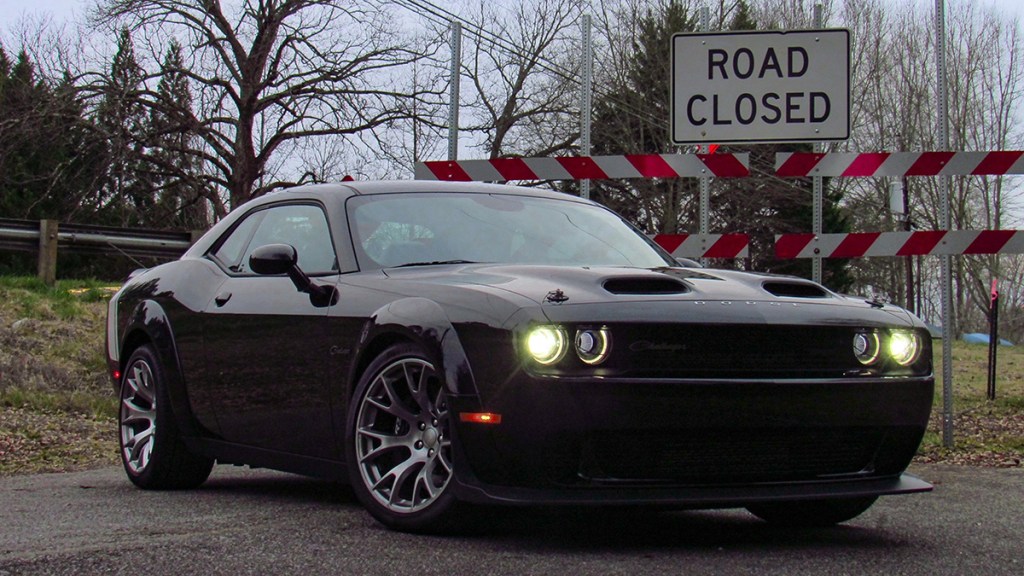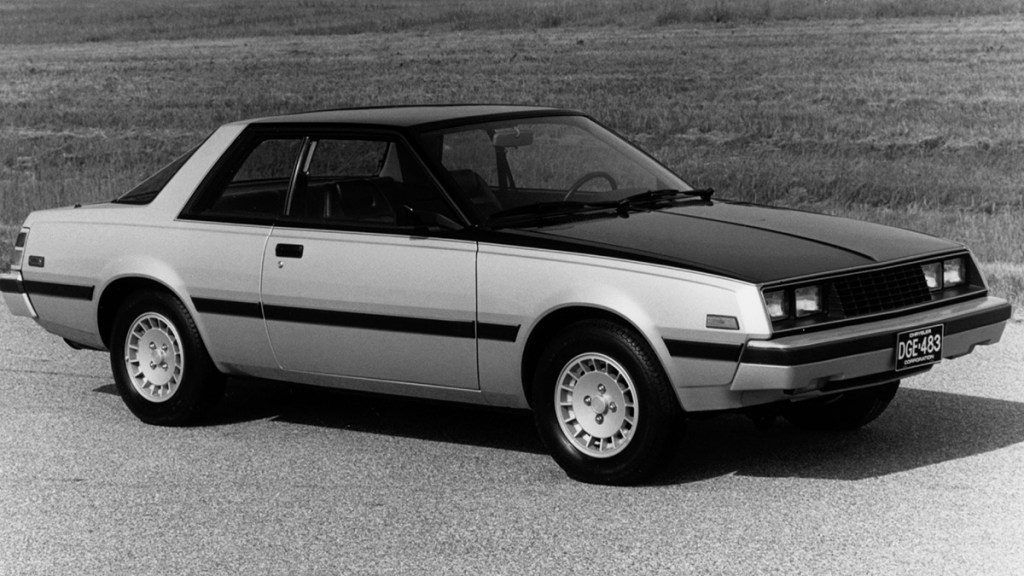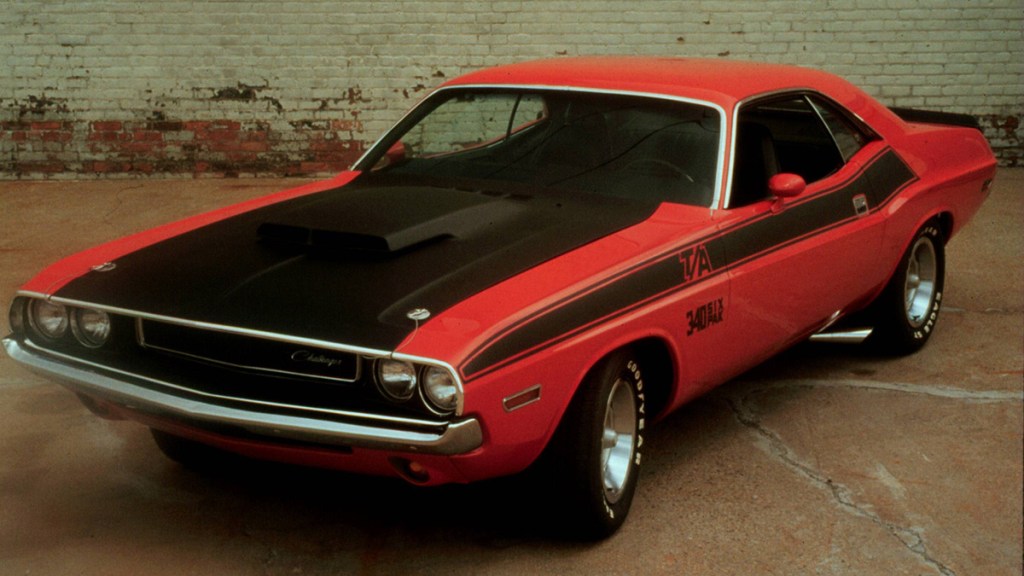Used Dodge Challenger Quick Facts
- If your budget allows, look for the 2019 to 2023 Hellcat, Hellcat Red Eye, SRT, and SRT Demon.
- If you’re looking for an inexpensive, sporty car that doesn’t need to peel the rubber off the tires, a 2017-2019 V6 Challenger SXT or GT is perfectly fine.
- For those seeking the rumble of a Hemi V8 without too much out of pocket, the R/T with its 5.7-liter engine is the best choice.
- The most powerful Challenger is the SRT Demon 170, which cranks out 1,025 horsepower.
The Dodge Challenger began its fascinating history in 1970. That’s when it was a more luxurious rival to cars like the Ford Mustang, Mercury Cougar, Chevrolet Camaro, and Pontiac Firebird. Though now legendary, the original Challenger didn’t sell in huge volumes and ceased production in 1974. The name briefly resurfaced in 1978, when it was applied to a Mitsubishi import that was neither fast nor terribly attractive. It wasn’t until 2008 that the Challenger returned as a bona fide muscle car, offering buyers a broad range of models, engines, body styles, and colors, as well as styling highly reminiscent of the original. For those who love the tradition of a rear-wheel-drive (RWD), high-powered American coupe, a used Dodge Challenger can be anything from a fun, affordable fling to an expensive future collectible. We’ll tell you the best years for buying a used Challenger.
- What Is the Best Model-Year Used Dodge Challenger?
- Dodge Challenger by Generation: Which Should You Buy?
- Is the Dodge Challenger a Good Car?
- How Fast Is the Dodge Challenger?
- Which Years Does the Challenger Have a Hemi V8?
- Does the Dodge Challenger Offer All-Wheel Drive (AWD)?
- What Are the Most Reliable Years for the Dodge Challenger?
- What Are the Years to Avoid for the Dodge Challenger?
What Is the Best Model-Year Used Dodge Challenger?
The current Challenger covers only one very long generation from 2008 until 2023. Given the nature of how hard these cars are driven, we’d avoid the early years due to their age and likely high miles. By 2017, Dodge ironed out most of the Challenger’s kinks and offered a range of upgrades such as all-wheel drive (AWD), supercharged V8s, and the widebody option.
If you’re looking for an inexpensive, sporty car that doesn’t need to peel the rubber off the tires, a 2017-2019 V6 Challenger SXT or GT is perfectly fine. For those seeking the rumble of a Hemi V8 without too much out of pocket, the R/T with its 5.7-liter engine is the best choice. Those with deep pockets and a need for speed will find several options, including the 2019-2023 Hellcat, Hellcat Red Eye, SRT, and SRT Demon.
A word about the 2020 and 2021 cars: These were the COVID-19 years, which may have limited the availability of some parts and options. These cars also sold for a higher premium than in other years, meaning private-party sellers, especially Hellcat owners, may not be willing to let them go at current market prices.
See Dodge Challenger cars for sale near you.
Dodge Challenger by Generation: Which Should You Buy?
Third Generation: 2008-2023

The Challenger’s run is a long one. As a used performance choice, we suspect most buyers are looking for one of the V8-powered variants. While the overall design hasn’t changed drastically over the years, the number of options, features, and engines has. The lineup begins with the V6-powered trims, which feature names like SE, SE Rallye, SXT, and GT. We’d go for one built after 2011 as they have the better Pentastar 3.6-liter V6 engine, which produces around 300 hp. Prior to 2011, these trims used a less powerful 3.5-liter V6.
Moving to the Challenger R/T brings a 5.7-liter Hemi V8 with horsepower starting around 370 and increasing as the model years climb. The V6 models are the only ones to offer the all-wheel-drive (AWD) option, which comes much later in the model run.
The most expensive (and collectible) of the Challenger series are the Scat Pack Widebody, SRT Hellcat, Hellcat Red Eye, and SRT models. These employ more powerful V8 engines with output ranging from 485 hp to 1,025 hp.
Regardless of the year, the Challenger has always been a good value. It has numerous standard features like power windows, cruise control, and air conditioning. Optional equipment varies by year but includes high-performance Harman Kardon audio systems, touchscreen infotainment with Apple CarPlay and Android Auto compatibility, navigation, heated seats, a heated steering wheel, and automatic climate control.
The more expensive performance trims offer things like sport seats, adjustable shocks, a Bilstein adaptive suspension, Brembo brakes, a limited-slip rear differential, and a shaker hood scoop.
Advanced driver assists like automatic emergency braking, adaptive cruise control, and blind-spot detection do not appear until 2015.
Model-Year Changes
2023: The Tremec 6-speed manual returns to the Hellcat. A series of commemorative badges and packages mark the Challenger’s final year, as does a limited production SRT 170 Demon. Running on E85 fuel, the Demon pumps out 1,025 hp and can reach 60 mph in under two seconds.
2022: Jailbreak, SRT Black, and Hemi Orange appearance packages arrive. Upper trims gain a new standard alarm.
2021: New trims include the 807-hp Super Stock, R/T Scat Pack Shaker Widebody, and T/A 392 Widebody. The Hellcat’s 6-speed manual has been removed.
2020: Limited production 50th Anniversary Edition.
2019: A new 797-hp Hellcat Redeye arrives, while the Hellcat sees output increase to 717 hp. All Scat Pack R/T models gain a power bulge hood, and the R/T joins the widebody club.
2018: The drag race-inspired SRT Demon arrives, touting an 840-hp supercharged V8.
2017: All-wheel drive appears for the first time, but only on the V6 trims.
2016: No major changes.
2015: A facelift brings a new front end and interior, as well as more advanced optional features like forward collision warning, automatic braking, adaptive cruise control, and a blind-spot monitor.
2014: No major changes.
2013: The Rallye Redline trim arrives, while the SRT8 392 gains standard launch control.
2012: A new 900-watt 18-speaker Harman Kardon audio system option arrives, while the SRT8 392 gains a 2-mode adjustable suspension and an available heated steering wheel.
2011: A new 3.6-liter V6, pushing 305 hp, joins the lineup, along with the arrival of the SRT8 392, which features a 470 hp 6.4-liter Hemi V8.
2010: The R/T trim offers a new Super Track Pack with 20-inch Goodyear tires, Sachs Nivomat self-leveling shocks, and a larger rear stabilizer bar.
2009: After its intro in 2008, the lineup expands to include SE, R/T, and SRT8.
2008: The Challenger SRT8 debuts with a 425-hp Hemi V8.
See 2008-2023 Dodge Challenger cars for sale near you.
The Dodge Challenger Early Years: Generations One and Two (1970-1983)
Second Generation: 1978-1983

The second-generation Challenger resembled the first in name only. It was attached to a 4-cylinder Mitsubishi import intended to battle the Honda Accord and Toyota Celica. Though sophisticated and sporty, true Challenger devotees never speak of it.
First Generation: 1970-1974

The iconic Challenger debuted in 1970. Based on the same platform as the less expensive Plymouth Barracuda, it was designed to challenge Ford and GM’s leading pony cars of the day. Several trims populated the Challenger order guide, with engines ranging from a 225-cubic-inch slant-6 to a 426-cubic-inch Hemi V8. Several engine options exist, including a 318, 340, 360, 383, and 440. Buyers could opt for a hardtop coupe or a soft-top convertible. Today, even a base model is highly desirable, with the magnum and six-pack models bringing big bucks at auction. The 1970 and 1971 models are the most desirable due to their high-horsepower, pre-emission engines.
See classic Dodge Challenger cars for sale near you.
Is the Dodge Challenger a Good Car?
The third-generation (2008-2023) Dodge Challenger is a good car for most of its run. Like many Chrysler products of this time, there are some issues with the transmissions and interior electronics, but after 2015, both quality and reliability improve. The V6 models offer good performance at a low price, making them ideal as both a hot rod and a comfortable daily cruiser. The Challenger is more family-friendly than the Ford Mustang and Chevrolet Camaro, thanks to a roomy rear seat and large trunk. There are a few recalls specific to individual model years. You can check to see which applies to the Challenger of your dreams by visiting our sister site, Kelley Blue Book, for recall information.
How Fast Is the Dodge Challenger?
Equipped with the 3.6-liter V6 engine, expect a third-generation Challenger to hit 60 mph in about seven seconds. The 5.7-liter Hemi knocks about two seconds off that time, while the supercharged Hemi in the Hellcat can make the zero-to-60-mph run in under four seconds. The 2023 SRT Super Stock makes the run at just a hair over three seconds, while the SRT 170 Demon does it in less than two.
Which Years Does the Dodge Challenger Have a Hemi V8?
The Hemi V8 shows up in the first- and third-generation Challenger years. For the modern-day Challenger, the Hemi includes the 5.7-liter V8 in the R/T, the 6.4-liter V8 in the Scat Pack and 392 models, and a supercharged 6.2-liter V8 in the Hellcat, Hellcat Redeye, and SRT Super Stock and Demon.
Does the Dodge Challenger Offer All-Wheel Drive?
The Challenger does offer all-wheel drive, but only on V6 trims after 2017.
What Are the Most Reliable Years for the Dodge Challenger?
Model years 2019 through 2023 are the most reliable years for the Challenger. Examples from 2015-2018 also have a fairly good track record but still have some issues with abrupt transmission shifting, cruise control malfunction, and some electrical gremlins under the hood.
What Are the Years to Avoid for the Dodge Challenger?
The early model cars from 2009 to 2014 are probably the least desirable, mostly due to their age and high mileage. Early models do have some issues with electronics, engine sensors, engine management computers, and temperamental transmissions.
RELATED: Best Dodge Charger Years to Buy Used











